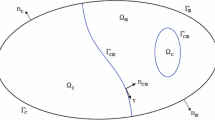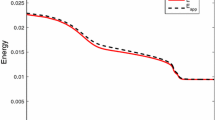Abstract
In this article we propose the Cahn–Hilliard–Navier–Stokes–Darcy–Boussinesq system that models thermal convection of two-phase flows in a fluid layer overlying a porous medium. Based on operator splitting and pressure stabilization we propose a family of fully decoupled numerical schemes such that the Navier–Stokes equations, the Darcy equations, the heat equation and the Cahn–Hilliard equation are solved independently at each time step, thus significantly reducing the computational cost. We show that the schemes preserve the underlying energy law and hence are unconditionally long-time stable. Numerical results are presented to demonstrate the accuracy and stability of the algorithms.





Similar content being viewed by others
References
Bénard, H.: Les tourbillons cellulaire dans nappe liquide transportant de la chaleur purconvections en regime permanent. Rev. Gen. Sci. Pures Appl. Bull. Assoc. 11, 1309–1328 (1900)
Cao, Y., Gunzburger, M., Hua, F., Wang, X.: Coupled Stokes–Darcy model with Beavers–Joseph interface boundary condition. Commun. Math. Sci. 8(1), 1–25 (2010)
Cardenas, M.B.: Hyporheic zone hydrologic science: a historical account of its emergence and a prospectus. Water Resour. Res. 51(5), 3601–3616 (2015)
Chen, J., Sun, S., Wang, X.-P.: A numerical method for a model of two-phase flow in a coupled free flow and porous media system. J. Comput. Phys. 268, 1–16 (2014)
Chen, N., Gunzburger, M., Wang, X.: Asymptotic analysis of the differences between the Stokes-Darcy system with different interface conditions and the Stokes–Brinkman system. J. Math. Anal. Appl. 368(2), 658–676 (2010)
Chen, W., Gunzburger, M., Hua, F., Wang, X.: A parallel Robin–Robin domain decomposition method for the Stokes–Darcy system. SIAM J. Numer. Anal. 49(3), 1064–1084 (2011)
Chen, W., Gunzburger, M., Sun, D., Wang, X.: Efficient and long-time accurate second-order methods for the Stokes–Darcy system. SIAM J. Numer. Anal. 51(5), 2563–2584 (2013)
Chen, W., Han, D., Wang, X.: Uniquely solvable and energy stable decoupled numerical schemes for the Cahn–Hilliard–Stokes–Darcy system for two-phase flows in karstic geometry. Numer. Math. 137(1), 229–255 (2017)
Chorin, A.J.: Numerical solution of the Navier–Stokes equations. Math. Comp. 22, 745–762 (1968)
Diegel, A.E., Wang, C., Wang, X., Wise, S.M.: Convergence analysis and error estimates for a second order accurate finite element method for the Cahn–Hilliard–Navier–Stokes system. Numer. Math. 137(3), 495–534 (2017)
Discacciati, M., Quarteroni, A.: Navier–Stokes/Darcy coupling: modeling, analysis, and numerical approximation. Rev. Mat. Complut. 22(2), 315–426 (2009)
Eyre, David J.: Unconditionally gradient stable time marching the Cahn–Hilliard equation. In: Computational and mathematical models of microstructural evolution (San Francisco, CA, 1998), vol. 529 of Materials Research Society Symposium Proceedings, pp. 39–46. MRS, Warrendale, PA, (1998)
Feng, X., Wise, S.: Analysis of a Darcy–Cahn–Hilliard diffuse interface model for the Hele–Shaw flow and its fully discrete finite element approximation. SIAM J. Numer. Anal. 50(3), 1320–1343 (2012)
Guillén-González, G.T.F.: On linear schemes for a Cahn–Hilliard diffuse interface model. J. Comput. Phys. 234, 140–171 (2013)
Girault, V., Raviart, P.-A.: Finite Element Methods for Navier–Stokes Equations: Theory and Algorithms. Springer Science & Business Media, Berlin (2012)
Girault, V., Rivière, B.: DG approximation of coupled Navier–Stokes and Darcy equations by Beaver–Joseph–Saffman interface condition. SIAM J. Numer. Anal. 47(3), 2052–2089 (2009)
Glasner, K., Orizaga, S.: Improving the accuracy of convexity splitting methods for gradient flow equations. J. Comput. Phys. 315, 52–64 (2016)
Gluyas, J.G., Swarbrick, R.E.: Petroleum Geology. Blackwell publishing, New Jersey (2004)
Gong, Y., Zhao, J., Wang, Q.: Arbitrarily high-order unconditionally energy stable schemes for thermodynamically consistent gradient flow models. SIAM J. Sci. Comput. 42(1), B135–B156 (2020)
Gong, Y., Zhao, J., Yang, X., Wang, Q.: Fully discrete second-order linear schemes for hydrodynamic phase field models of binary viscous fluid flows with variable densities. SIAM J. Sci. Comput. 40(1), B138–B167 (2018)
Guo, Z., Lin, P.: A thermodynamically consistent phase-field model for two-phase flows with thermocapillary effects. J. Fluid Mech. 766, 226–271 (2015)
Guo, Z., Lin, P., Lowengrub, J., Wise, S.: Mass conservative and energy stable finite difference methods for the quasi-incompressible Navier–Stokes–Cahn–Hilliard system: primitive variable and projection-type schemes. Comput. Methods Appl. Mech. Engrg. 326, 144–174 (2017)
Han, D.: A decoupled unconditionally stable numerical scheme for the Cahn–Hilliard–Hele–Shaw system. J. Sci. Comput. 66(3), 1102–1121 (2016)
Han, D., Sun, D., Wang, X.: Two-phase flows in karstic geometry. Math. Methods Appl. Sci. 37(18), 3048–3063 (2014)
Han, D., Wang, X.: A second order in time, uniquely solvable, unconditionally stable numerical scheme for Cahn–Hilliard–Navier–Stokes equation. J. Comput. Phys. 290, 139–156 (2015)
Han, D., Wang, X., Hao, W.: Existence and uniqueness of global weak solutions to a Cahn–Hilliard–Stokes–Darcy system for two phase incompressible flows in karstic geometry. J. Differ. Equ. 257(10), 3887–3933 (2014)
He, Q., Glowinski, R., Wang, X.-P.: A least-squares/finite element method for the numerical solution of the Navier–Stokes–Cahn–Hilliard system modeling the motion of the contact line. J. Comput. Phys. 230(12), 4991–5009 (2011)
Hecht, F.: New development in freefem++. J. Numer. Math. 20(3–4), 251–266 (2012)
Hill, A.A., Straughan, B.: Global stability for thermal convection in a fluid overlying a highly porous material. Proc. R. Soc. Lond. Ser. A Math. Phys. Eng. Sci. 465(2101), 207–217 (2009)
Kay, D., Styles, V., Welford, R.: Finite element approximation of a Cahn–Hilliard–Navier–Stokes system. Interfaces Free Bound 10(1), 15–43 (2008)
Kim, J., Kang, K., Lowengrub, J.: Conservative multigrid methods for Cahn–Hilliard fluids. J. Comput. Phys. 193(2), 511–543 (2004)
Layton, W.J., Schieweck, F., Yotov, I.: Coupling fluid flow with porous media flow. SIAM J. Numer. Anal. 40(6), 2195–2218 (2003). 2002
Minjeaud, S.: An unconditionally stable uncoupled scheme for a triphasic Cahn–Hilliard/Navier–Stokes model. Numer. Methods Partial Differ. Equ. 29(2), 584–618 (2013)
Shen, J.: Modeling and Numerical Approximation of Two-phase Incompressible Flows by a Phase-Field Approach in Multiscale Modeling and Analysis for Materials Simulation, pp. 147–195. World Scientific, Singapore (2012)
Shen, J., Wang, C., Wang, X., Wise, S.M.: Second-order convex splitting schemes for gradient flows with Ehrlich–Schwoebel type energy: application to thin film epitaxy. SIAM J. Numer. Anal. 50(1), 105–125 (2012)
Shen, J., Jie, X., Yang, J.: The scalar auxiliary variable (SAV) approach for gradient flows. J. Comput. Phys. 353, 407–416 (2018)
Shen, J., Jie, X., Yang, J.: A new class of efficient and robust energy stable schemes for gradient flows. SIAM Rev. 61(3), 474–506 (2019)
Shen, J., Yang, X.: Numerical approximations of Allen–Cahn and Cahn–Hilliard equations. Discrete Contin. Dyn. Syst. 28(4), 1669–1691 (2010)
Shen, J., Yang, X.: Decoupled, energy stable schemes for phase-field models of two-phase incompressible flows. SIAM J. Numer. Anal. 53(1), 279–296 (2015)
Stuart, A.M., Elliott, C.M.: The global dynamics of discrete semilinear parabolic equations. SIAM J. Numer. Anal. 30(6), 1622–1663 (1993)
Taylor, Charles J., Greene, Earl A.: Quantitative approaches in characterizing karst aquifers. Water resources investigations report 01-4011, (2001)
Temam, R.: Une méthode d’approximation de la solution des équations de Navier–Stokes. Bull. Soc. Math. France 96, 115–152 (1968)
Tüber, K., Pócza, D., Hebling, C.: Visualization of water buildup in the cathode of a transparent pem fuel cell. J. Power Sour. 124(2), 403–414 (2003)
Wise, S.: Unconditionally stable finite difference, nonlinear multigrid simulation of the Cahn–Hilliard–Hele–Shaw system of equations. J. Sci. Comput. 44(1), 38–68 (2010)
Yang, X., Lili, J.: Linear and unconditionally energy stable schemes for the binary fluid-surfactant phase field model. Comput. Methods Appl. Mech. Engrg. 318, 1005–1029 (2017)
Yang, X., Zhao, J., Wang, Q.: Numerical approximations for the molecular beam epitaxial growth model based on the invariant energy quadratization method. J. Comput. Phys. 333, 104–127 (2017)
Zhao, J., Yang, X., Gong, Y., Wang, Q.: A novel linear second order unconditionally energy stable scheme for a hydrodynamic \({\bf Q}\)-tensor model of liquid crystals. Comput. Methods Appl. Mech. Engrg. 318, 803–825 (2017)
Author information
Authors and Affiliations
Corresponding author
Additional information
Publisher's Note
Springer Nature remains neutral with regard to jurisdictional claims in published maps and institutional affiliations.
W. Chen and Y. Zhang are supported by the National Science Foundation of China (11671098, 91630309, 12071090). D. Han acknowledges support from NSF-DMS-1912715. X. Wang thanks support from NSFC11871159 and Guangdong Provincial Key Laboratory via 2019B030301001.
Rights and permissions
About this article
Cite this article
Chen, W., Han, D., Wang, X. et al. Uniquely Solvable and Energy Stable Decoupled Numerical Schemes for the Cahn–Hilliard–Navier–Stokes–Darcy–Boussinesq System. J Sci Comput 85, 45 (2020). https://doi.org/10.1007/s10915-020-01341-7
Received:
Revised:
Accepted:
Published:
DOI: https://doi.org/10.1007/s10915-020-01341-7




